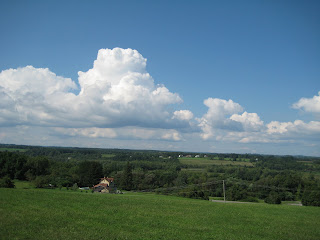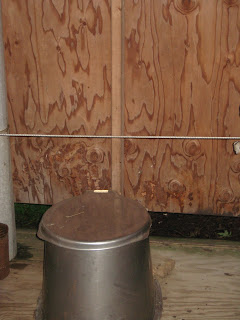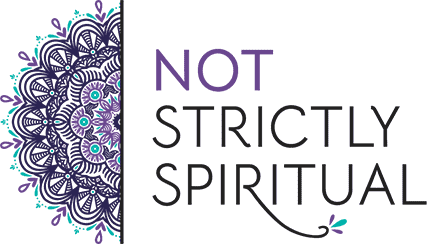by Mary | Aug 24, 2009 | Uncategorized

Earlier this week, I posted about the possibility that Blessed Kateri Tekakwitha, Lily of the Mohawks, is one step closer to canonization. Well, today I happened to be at the National Shrine of the North American Martyrs in Auriesville, N.Y., birthplace of Blessed Kateri. I thought I would share some photos with you in hopes that it will inspire you to visit the shrine, which is open until mid-October and then closes (New York winters, you know) until the first week of May.
The view of the surrounding countryside and Mohawk River from the Visitors’ Center and Gift Shop:

The three crosses marking the entrance to the main grounds. The crosses bear the names of three martyrs tortured and killed on the grounds where the shrine now stands: St. Isaac Jogues, Jesuit priest; St. Rene Goupil, Jesuit Brother; and St. John Lalande, lay missioner:

Coliseum church, which was built in 1930 and can seat 6,000:

Replica of the Our Lady of Fatima statue that stands in the Vatican Gardens:
 Rose bush beneath Our Lady of Fatima, hung with the Rosary beads of pilgrims:
Rose bush beneath Our Lady of Fatima, hung with the Rosary beads of pilgrims:

Kateri Chapel, a simple screened-in building, where daily Mass is celebrated:

Many (most) of the trees on the main grounds are marked with crosses and the name of Jesus in honor of St. Isaac Jogues, who taught the faith by carving the basics into trees:

Across the street from the main shrine grounds is the ravine, where you can read in St. Isaac Jogues’ own words an account of the death of St. Rene Goupil. It is a peaceful and powerful place:
 In the ravine is the Shrine to Our Lady of the Way. It’s explained in the photo under this one (click to enlarge and read):
In the ravine is the Shrine to Our Lady of the Way. It’s explained in the photo under this one (click to enlarge and read):

 A bridge leading back to the main path of the ravine:
A bridge leading back to the main path of the ravine:

And, once you’re finished at the shrine, stop off here for some ice cream and fresh veggies on your way back to the highway:




by Mary | Aug 23, 2009 | faith
Earlier this summer, I did a spiritual exercise of sorts where I read through the first ten chapters of the Gospel of John slowly, one chapter on each day of my vacation, and then jotted down the one thing from each that stood out. A modified version of Lectio Divina, I guess. All of the readings were familiar, but one stood out in those ten days, the one we heard in today’s Gospel from Chapter 6. It is the latter part of the Bread of Life discourse, where Jesus has told his followers that they must eat his body and drink his blood in order to have everlasting life.
“As a result of this, many of his disciples returned to their former way of life and no longer accompanied him. Jesus then said to the Twelve, “Do you also want to leave?” Simon Peter answered him, “Master, to whom shall we go?”
I am intrigued –and in some ways, comforted — by the fact that many left and went back to their former lives. The Eucharist is such a shocking concept to them. “The saying is hard; who can accept it?” Even then, even in the presence of Jesus actually saying that we must eat his body and drink his blood, many disciples couldn’t accept it. So no wonder it is hard for us to grasp it fully and allow it to change our lives.
And Peter’s response — “To whom shall we go?” — isn’t exactly a ringing endorsement of what Jesus has just said. He doesn’t say that he “gets” the teaching on Eucharist, does he? Just that he cannot imagine leaving Jesus. Yet another reason to love Peter. His honesty is refreshing. Despite his tendency to say or do the wrong thing at the wrong time, he believed. He doubted and denied, but at the end of the day, despite his shortcomings, he was the one Jesus entrusted with his Church.
To whom shall we go? Sometimes I think that fits my relationship with my faith so perfectly. I’m constantly trying to find my place, to really understand what I’m called to do and be. And yet so often I fall short. But where else would I go? If I’m going to believe in something, why would I go searching for anything else. Jesus is here.
That’s why I find such comfort in Peter in this Gospel reading. He’s not saying, Yes, Lord, I understand. He’s saying, “Where else am I going to go?” And that’s enough, isn’t it? Jesus asks us to follow. He recognizes that it’s not always easy. He doesn’t demand that we completely understand every single teaching but that we believe and trust in him. “Lord, to whom shall we go?” There is no place else but here, with Jesus. For Peter, for us, for all time.
by Mary | Aug 21, 2009 | Uncategorized

Here’s my August Life Lines column:
My brother and sister and I used to joke about the fact that when we were kids, our family went back to the same Wildwood Crest motel year after year, ate at the same Italian restaurant while we were there, and even ordered our annual Sicilian pizza and zeppolis from the same businesses on the boardwalk. We were creatures of habit, which on the surface may seem dull but in reality is exactly the kind of thing that makes for lots of happy memories.
Dennis and I now take our own children to North Wildwood year after year. We stay in the same condo, order from the same seafood take-out restaurant, like certain pizza places on the boardwalk and one particular hot dog joint that serves veggie dogs for the non-meat eaters in the family. We have created our own vacation rituals that are now on the kids’ “must-do” list every summer.
This year, as we were sitting on the beach trying to decide which of our usual haunts to visit later that day, Dennis said, “Do you think one day the kids will look back at this and joke about how we went to the same places every year?” And I shot back, without a second’s hesitation, “No!” Because, despite the fact that my siblings and I would joke about it now and then, the truth is that those summer rituals gave us lifelong memories, memories so strong that I want my own children to experience them.
When we walk on the boardwalk, it’s the same boardwalk I traversed as a teen-ager. When I stare out at the ocean, I think back to the walks I took along those same shores with my mother, of the crowded but happy beach blanket filled not only with my immediate family but grandmothers and cousins, of long car rides with too much stuff piled into every crevice of our big Ford Galaxy.
Rituals are important in life. They serve as touchstones that remind us of people and places that hold special spots in our hearts. They give shape to our lives and, often, order to our days. And just as family rituals bind us to our biological heritage and connect our past to our future, faith rituals bind us to our Church family and connect us to the Divine.
The stained-glass windows, the incense, the prayers of the Mass said day after day, the hymns and holy water, the candles and statues – all of them combine to create rituals that not only feed our spiritual lives but leave a lasting imprint on our hearts and souls of what it means to be Catholic.
Sadly, we’ve give up on a lot of the rituals that make both family life and faith life special. Fast food has replaced big family meals eaten slowly around a kitchen table. Statues and stained glass seem old-fashioned to our modern sensibilities. But as we shed the physical ties that bind us to our families or our faith, we lose critical connections.
When I give presentations on the Catholic faith at conferences or parishes, I focus heavily on rituals because the increasing disconnect from the so-called “bells and smells” of Catholicism today plays a big part in the larger disconnect from the faith in general. We’re only human after all, and we need those tactile traditions to help us make that giant leap toward heaven. Rituals are not just nice; they’re necessary.
Before summer is over, try to rediscover some rituals from your own past – perhaps one family ritual and one faith ritual – and see for yourself just how special they can be. It may be something as simple as flying a kite on the beach, but it’s bound to touch you in deep and maybe surprising ways, reminding you of times gone by and, perhaps, leading you home.
2009 Copyright Mary DeTurris Poust. All Rights Reserved.
by Mary | Aug 18, 2009 | Uncategorized

So I spent three days (actually a little more) at Boy Scout camp last week, and lived to tell the tale. And a happy tale at that, even with “semi-open” latrines that could bring tears to your eyes from 10 feet away. It was a great experience, so good that I extended my stay and added on an extra day and night. Believe me, coming from this non-camper, that’s a pretty big deal. In fact, I would have to say that I can no longer label myself a non-camper. After two fabulous Boy Scout camping experiences and one horrendous but survivable Girl Scout camping experience, I am really, truly a camper. I loved it, and I’m looking for the first opportunity to go on a family camping trip.
Here are some photos of my days at Rotary Scout Reservation. The one thing I don’t have a photo of is my afternoon at the rifle range, which is too bad since I nailed that little target. I’ve got the paper to prove it. Don’t mess with Mary.
On to our photos… (If you click on the photos, it will enlarge them.)
Noah diving at the lake and my little tent in the woods:


Noah climbing the grotto near our site and Noah and me at dusk:


Noah and Noah at the lake, and Chiara and Michael on family night:


Lots of pretty fungi that Noah and I found on a hike, and a little lost toad:




Last morning around the dying campfire:

Flag ceremony. That’s Troop 71’s flag flying over Rotary since our boys earned 100 percent on their site inspection that morning:

And lest you think it was all fun and games, here’s a shot of the dreaded latrine with no doors. Quite a fitting ending to this little Ode to the Boy Scouts, don’t you think?

by Mary | Aug 10, 2009 | family
My post from OSV Daily Take today:
As soon as I saw “Coffee Can Wait. Day’s First Stop Is Online” in today’s New York Times, I felt a mix of relief and disappointment. Relief because apparently my family is not unusual in our new and semi-constant quest to be connected to everyone we know via Facbeook, Twitter, email, Instant Messager and Skype, even before we pour that first cup of coffee or pop a piece of bread in the toaster. Disappointment because this new way of life is not necessarily a good way of life. I recognize that even as I pause to check Twitter one more time before bed or to post a status update to Facebook at 5:15 a.m. as I head out the door to yoga class, something that would have seemed insane just a year or so ago.
At our house, you will often find my husband, Dennis, on his iPhone, my son on the laptop, and me on the computer in the family room, all simultaneously. On the weekends, when we don’t get the old-fashioned version of the Times, Dennis has the laptop on the kitchen table as he sips coffee. At dinner, if I don’t remember to turn down the volume, we can often hear the distracting beeps and dings of various communications being received. Like our telephone rule — no calls taken during meals no matter what — we don’t check on the latest urgent post from some far-flung Facebook friend, but it still has the ability to cause a minor disruption in kitchen-table conversation.
From today’s New York Times:
“In other households, the impulse to go online before getting out the door adds an extra layer of chaos to the already discombobulating morning scramble.
“Weekday mornings have long been frenetic, disjointed affairs. Now families that used to fight over the shower or the newspaper tussle over access to the lone household computer — or about whether they should be using gadgets at all, instead of communicating with one another.
“’They used to have blankies; now they have phones, which even have their own umbilical cord right to the charger,’ said Liz Perle, a mother in San Francisco who laments the early-morning technology immersion of her two teenage children. ‘If their beds were far from the power outlets, they would probably sleep on the floor.’
“The surge of early risers is reflected in online and wireless traffic patterns. Internet companies that used to watch traffic levels rise only when people booted up at work now see the uptick much earlier.
“Arbor Networks, a Boston company that analyzes Internet use, says that Web traffic in the United States gradually declines from midnight to around 6 a.m. on the East Coast and then gets a huge morning caffeine jolt. “It’s a rocket ship that takes off at 7 a.m,” said Craig Labovitz, Arbor’s chief scientist.”
One family in the story opted to go offline on weekends, which is a great idea, although I don’t think I could get anyone in my house, except maybe our 4-year-old, to go entire weekends without going online. After all, this has become our primary mode of communication with friends and family. It’s part of our jobs. It’s part of everyday life now, like it or not.
I think the technology takeover is one reason this non-camping mom has suddenly become interested in heading for the mountains and pitching a tent. To be unplugged and communing with nature and each other without any distractions seems like a dream. Of course, as I write this my husband is posting Facebook status updates from a Boy Scout camp in the woods. It may be a losing battle.
So how do we use technology wisely without letting it become an obsession? Probably the same way we used to rein in TV time when the kids were little, only now the parents need to be reined in too. How are you dealing with the influx of technology into your homes? Share in the comment section so we can all benefit.
To read the full New York Times story, click HERE.
Rose bush beneath Our Lady of Fatima, hung with the Rosary beads of pilgrims:
In the ravine is the Shrine to Our Lady of the Way. It’s explained in the photo under this one (click to enlarge and read):
A bridge leading back to the main path of the ravine:



